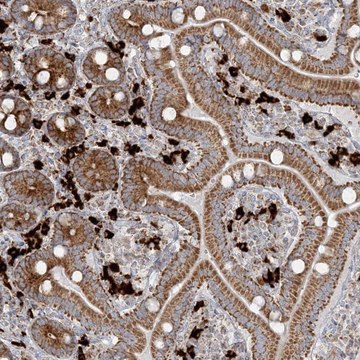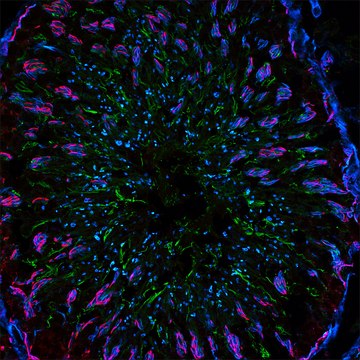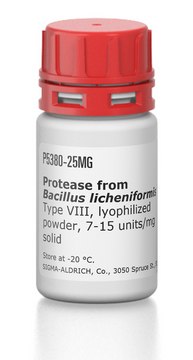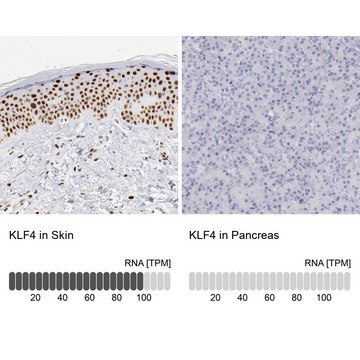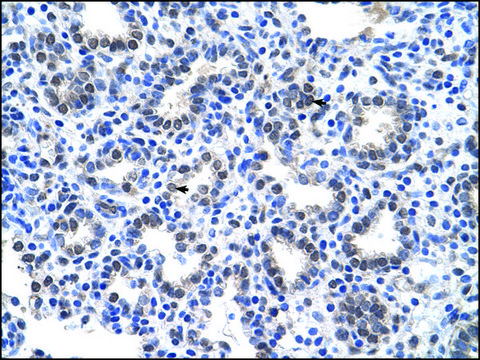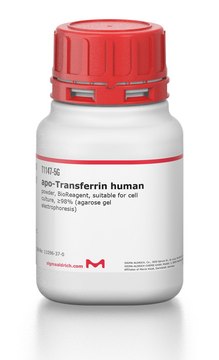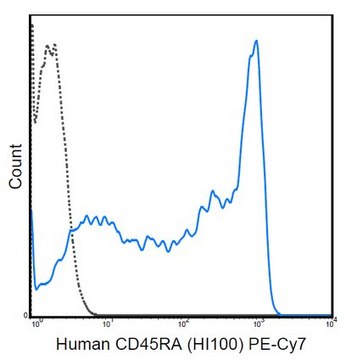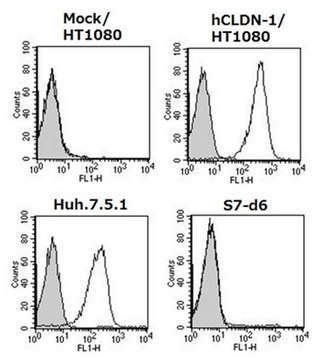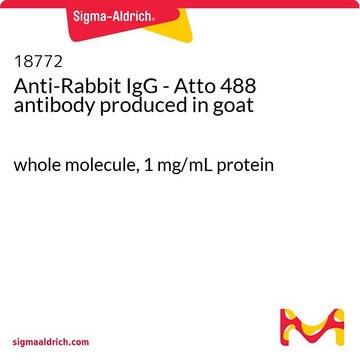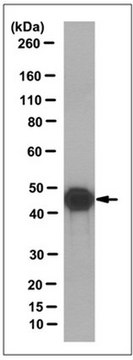推荐产品
生物来源
mouse
质量水平
抗体形式
purified immunoglobulin
抗体产品类型
primary antibodies
克隆
KT110, monoclonal
种属反应性
mouse, human
技术
electrophoretic mobility shift assay: suitable
immunohistochemistry: suitable
western blot: suitable
同位素/亚型
IgG1κ
NCBI登记号
UniProt登记号
运输
wet ice
靶向翻译后修饰
unmodified
基因信息
human ... SLC22A16(85413)
一般描述
八聚体结合蛋白6(Oct-6)又称为POU结构域第3类转录因子1(Pou3f1)、八聚体结合转录因子6(OTF-6)和POU结构域转录因子SCIP。Oct-6是一种特异性结合(5′-ATTTGCAT-3′)八聚体基序的转录因子。Oct-6与周围神经系统的早期胚胎发生、神经发生、角化细胞分化和髓鞘形成有关。
免疫原
对应于小鼠OCT6的重组蛋白。
应用
免疫组化分析:代表性批次的1:100稀释液在小鼠胚胎大脑(D15.5)组织中检测到OCT6。
电泳迁移率变动分析(EMSA):代表性批次在RT4神经鞘瘤或原代大鼠Shcwann细胞的核提取物中检测到SphK1(D. Meijer教授,鹿特丹伊拉斯谟大学医学中心)。
电泳迁移率变动分析(EMSA):代表性批次在RT4神经鞘瘤或原代大鼠Shcwann细胞的核提取物中检测到SphK1(D. Meijer教授,鹿特丹伊拉斯谟大学医学中心)。
抗-OCT6抗体(克隆KT110 )是一种高度特异性的小鼠单克隆抗体,靶向Oct-6,已在蛋白质印迹、IHC和电泳迁移率变化分析中进行了检验。
研究子类别
发育信号转导
发育信号转导
研究类别
神经科学
神经科学
质量
通过蛋白质印迹在H9人胚胎干细胞裂解液中进行评估。
蛋白质印迹分析:1.0 µg/mL该抗体在10 µg H9人胚胎干细胞裂解液中检测到OCT6。
蛋白质印迹分析:1.0 µg/mL该抗体在10 µg H9人胚胎干细胞裂解液中检测到OCT6。
目标描述
观测分子量〜50 kDa
联系
替代:MABN1060
外形
形式:纯化
纯化的小鼠单克隆IgG1κ,溶于含PBS和0.9%叠氮化钠的缓冲液中。
纯化蛋白A
储存及稳定性
自收到之日起,在2-8°C条件下可稳定保存1年。
其他说明
浓度:请参考批次特异性浓缩物的检验报告。
免责声明
除非我们的产品目录或产品附带的其他公司文档另有说明,否则我们的产品仅供研究使用,不得用于任何其他目的,包括但不限于未经授权的商业用途、体外诊断用途、离体或体内治疗用途或任何类型的消费或应用于人类或动物。
未找到合适的产品?
试试我们的产品选型工具.
储存分类代码
10 - Combustible liquids
WGK
WGK 2
闪点(°F)
Not applicable
闪点(°C)
Not applicable
Vittoria Dickinson Bocchi et al.
Science (New York, N.Y.), 372(6542) (2021-05-08)
Deciphering how the human striatum develops is necessary for understanding the diseases that affect this region. To decode the transcriptional modules that regulate this structure during development, we compiled a catalog of 1116 long intergenic noncoding RNAs (lincRNAs) identified de
Michel Fries et al.
Cell reports, 42(8), 112985-112985 (2023-08-17)
The balance of contralateral and ipsilateral retinogeniculate projections is critical for binocular vision, but the transcriptional programs regulating this process remain ill defined. Here we show that the Pou class homeobox protein POU3F1 is expressed in nascent mouse contralateral retinal
Masaki Kinoshita et al.
Cell stem cell, 28(3), 453-471 (2020-12-04)
Pluripotent cells emerge as a naive founder population in the blastocyst, acquire capacity for germline and soma formation, and then undergo lineage priming. Mouse embryonic stem cells (ESCs) and epiblast-derived stem cells (EpiSCs) represent the initial naive and final primed
Joshua Po Han Wu et al.
Frontiers in molecular neuroscience, 15, 921901-921901 (2022-08-09)
The cerebellar nuclear (CN) neurons are a molecularly heterogeneous population whose specification into the different cerebellar nuclei is defined by the expression of varying sets of transcription factors. Here, we present a novel molecular marker, Pou3f1, that delineates specific sets
Sophie M Morgani et al.
Methods in molecular biology (Clifton, N.J.), 2214, 41-58 (2020-09-19)
Pluripotent stem cells (PSCs) are the in vitro counterpart of the pluripotent epiblast of the mammalian embryo with the capacity to generate all cell types of the adult organism. During development, the three definitive germ layers are specified and simultaneously
我们的科学家团队拥有各种研究领域经验,包括生命科学、材料科学、化学合成、色谱、分析及许多其他领域.
联系技术服务部门